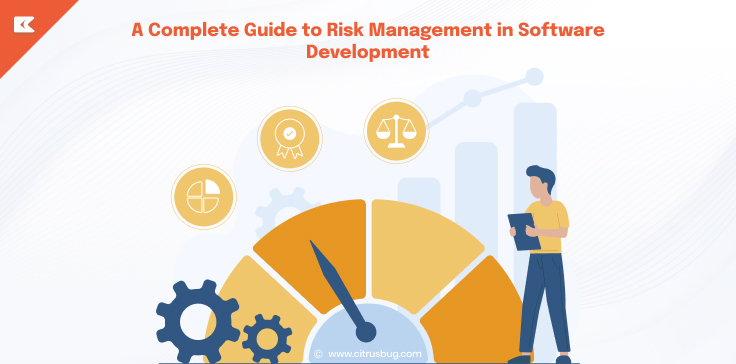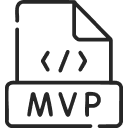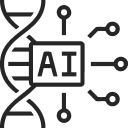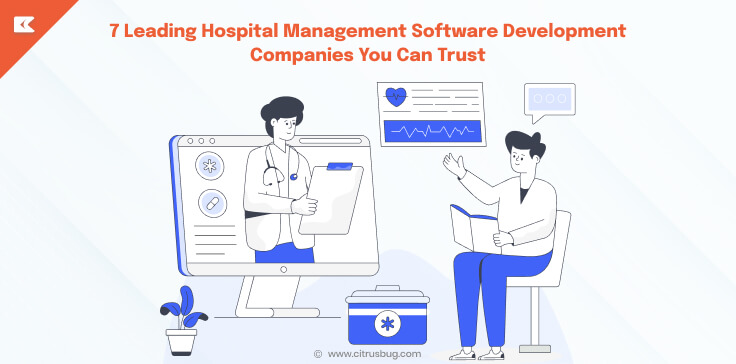A Complete Guide to Risk Management in Software Development
- November 3, 2025
-
321 Views
- by Ishan Vyas
Table of Contents

Every software project faces uncertainty. Changing requirements, tight deadlines, or new technologies can easily disrupt progress. This is the reason why risk management in software development is necessary. It assists the team to anticipate problems, design solutions, and produce the project within time and budget.
Effective Risk management generates confidence and reliability. It minimizes the rework, enhances the quality of software and secures business objectives. According to a report, poor risk management contributes to more than 30% project failures in industries. This shows the significance of the risk management approach as an orderly strategy.
In this guide, you will learn how software teams can identify, assess, and handle potential risks throughout the development lifecycle. You will also learn how the proactive approach can be used to develop credible, scalable and successful custom software solutions.
What Is Software Risk and Its Types?
A software risk is any potential event or condition that can negatively affect a project’s objectives. Risks can affect the timelines, cost, quality or performance. Early awareness of these risks enables teams to prepare in advance to mitigate the risks.
Software risks generally fall into four main categories:
- Technical Risks: Technical problems, integration, or poor code. As an example, a wrong set of framework can increase the probability of bugs and delays.
- Project Management Risks: Planning, scheduling or resource allocation problems. Usual causes are scope creep and unrealistic deadlines.
- Operational Risks: These risks are related to the availability of the teams, breakdown in infrastructure or inefficient processes. A sudden loss of a key developer can disrupt progress significantly.
- External Risks: The external risks are those factors that are not within the development team’s control, such as regulatory changes, vendor dependencies, or market shifts. These can add delays or extra costs that were not anticipated.
The earliest possible detection of those risks in the software development lifecycle assists the teams in developing effective mitigation strategies. Those organizations that proactively deal with risks are much more successful in their project delivery.
Knowing the kind of risk enables the teams to select the appropriate method to mitigate its effects to make the AI development process more comfortable and achieve improved business results.
Process of Risk Management in Software Development
Risk management in software development is a process that requires proper management. Each stage is based on the previous one and risks are being identified, mitigated, and tracked throughout the project.
Step 1: Identify Potential Risks
The first step is spotting possible challenges before they become problems. Teams explore technical complexities, availability of resources, time pressure and dependencies in projects. Early identification allows teams to prepare in advance and reduces surprises during development.
Step 2: Assess Probability and Impact
When risks are identified, the teams consider the probability of occurrence of each risk and the severity of the consequences. Some risks can delay the project, but some may affect the quality of the software or increase the cost. Understanding probability and impact can be helpful in prioritizing risks and investing resources in areas that will affect it the most.
Step 3: Plan Mitigation and Response
The teams develop a mitigation plan for each risk after assessment. This can involve further testing, time scheduling, re-allocation of resources or contingency planning. Effective communication is one that makes all team members understand their roles and procedures that have to be followed to minimize risk.
Step 4: Monitor and Review Continuously
Risk management in software development is not a one-time task. In the custom AI software development life cycle, the teams keep track of the risks and revise the plans whenever new risks are detected. Consistent monitoring guarantees that mitigating measures are successfully applied and the lessons learnt are utilized in subsequent projects.
Through this process, development teams can minimize delays, cost and produce high-quality software that fulfils business goals.
Key Risk Factors at Different SDLC Stages
Knowing risk factors during all lifecycle phases of a software or web application development process enables teams to avoid delays and enhance the quality of the software.
| SDLC Stage | Key Risk Factors |
|---|---|
| Planning Stage |
|
| Development Stage |
|
| Testing Stage |
|
| Deployment & Maintenance |
|
Creating a Risk Management in Software Development Plan
A risk management plan is simply a plan for dealing with issues before they occur. When handing over a new project to a software outsourcing firm, it is also important to create a plan to ensure that the project is on schedule.
Risk Register
This is a list of all the risks that the team has identified. It contains the description of what the risk is, what can go wrong and how serious it may be. Think of it as your project’s risk diary.
Risk Assessment
Not all risks are equal. In this case, the team considers the probability of a risk and its potential impact on the project. This helps in determining what risks should be addressed urgently.
Mitigation and Contingency Plans
The team determines what to do to mitigate each risk or what backup plan to adopt in case it occurs. Assigning someone to manage each risk makes sure nothing falls through the cracks.
Communication Plan
Everybody must be aware of what is happening. This part covers the frequency and the way the team communicates with stakeholders on the risks.
Monitoring and Review
Risks aren’t static. The plan indicates how the team will monitor risks throughout the project and revise the plan in case of emerging risks. Lessons learnt are also summarized to enhance future projects.
A straightforward, transparent risk management plan ensures that the team is ready, minimizes any surprises and the software project goes in. Companies that rely on outsourcing software development services should ensure that vendors follow the same structured approach to risk assessment and mitigation.
Risk Mitigation Strategies in Software Projects
Handling risks is not only about identifying issues; it is about minimizing them before they interfere with your project. The following are some of the practical ways that teams apply to remain ahead:
Preventive Actions
The most effective risk management is to prevent it. This may be in terms of writing maintainable code, adhering to coding standards or the use of tested technologies to prevent technical problems. According to the report, isk management can avoid up to 90% of the project’s problems
Regular Testing and Reviews
Regular code review, automated testing and frequent QA cycles are helpful in identifying errors at an early stage. Earlier problem identification helps to save time and eliminates expensive rework in the future.
Agile and Iterative Development
The division of the project into smaller sprints enables teams to evolve fast. In case a risk appears, it can be solved without compromising the whole project timeline.
Backup and Contingency Plans
In some cases, risks are unavoidable. The presence of a backup strategy like alternative workflow, extra resources or even additional testing makes sure that the project goes on schedule despite problems taking place.
Clear Communication
Risks affect everyone. Constant updates and open communication keep the stakeholders and team updated. This helps in making decisions faster and minimizing misunderstandings.
Continuous Monitoring
Risks evolve over time. Monitoring them regularly guarantees that emerging concerns are detected promptly and corrective measures are modified accordingly.
Using these strategies, software teams can reduce the number of disruptions, keep the projects on schedule, and produce quality results that will address business objectives.
Tools for Managing Software Risks
With proper tools, software risks are an easier thing to manage. They assist teams to trace problems, distribute responsibility, and maintain awareness of possible problems.
1. Jira
Jira is a famous project management tool, which allows teams to monitor tasks, dependencies and risks in real time. It makes people aware of possible problems.
2. Wrike
Similar to Jira, Wrike helps a team to organize projects, track development, and report risks in a limited time. Its dashboards are easy to visualize problem areas.
3. Risk Register
A document that captures all the identified risks, probability, impact, and mitigation. It keeps the team on track and there is no risk that is left unaddressed.
The regular utilization of these tools enables software teams to remain proactive, minimize surprises and produce high-quality projects on schedule.
Best Practices for Effective Software Risk Management
Risk management is not just a matter of tools and processes; it involves intelligent use of best practices to ensure that projects stay on schedule.
Start Early
Determine risks at the earliest stage of the project. The sooner you identify possible problems, the less they will impact timelines or quality.
Involve the Whole Team
Risk management isn’t just for project managers. Developers, testers, and other stakeholders should all contribute. Different perspectives help uncover risks that might otherwise be missed.
Prioritize Risks
Not all risks are equal. Pay attention to the most impactful and probable ones first. This makes sure that resources are utilized effectively.
Keep It Visible
Track risks in a central location and update them regularly. Transparency makes people aware of what to be aware of and take action in case a risk occurs.
Have Clear Mitigation Plans
All risks identified must be planned. Clarity can make the difference in the team, whether it comes to preventive actions or contingency actions.
Review and Learn Continuously
Risks are changing with the project development. Regularly review and update the risk register, and capture lessons learned for future projects. Constant learning enhances general risk management.
By following these best practices, teams can manage risks effectively, reduce delays, control custom software development costs, and deliver projects successfully.
Conclusion
Risk management in software development is an essential part of ensuring high-quality projects delivered on time and on budget. By early identifying problems, evaluating their effects, and adopting mitigation measures, teams can reduce unexpected events and maintain development as anticipated.
With the right tools and best practices, a structured approach can also make sure that risks are preempted and proactively tackled. Such a mindset enhances decision-making, teamwork, and guarding business agendas.
At Citrusbug, we assist businesses with the application of proper risk management as a part of the custom AI development service. Our experience makes sure that each project is well planned, monitored and delivered with limited risk, whereby clients can attain their objectives with confidence.
With such strategies, software teams can minimize project disruptions and provide solutions that will create measurable business value and long-term success.





 SaaS Development
SaaS Development Web Application Development
Web Application Development Mobile Application Development
Mobile Application Development Custom Software Development
Custom Software Development Cloud Development
Cloud Development DevOps Development
DevOps Development MVP Development
MVP Development Digital Product Development
Digital Product Development Hire Chatbot Developers
Hire Chatbot Developers Hire Python Developers
Hire Python Developers Hire Django Developers
Hire Django Developers Hire ReactJS Developers
Hire ReactJS Developers Hire AngularJS Developers
Hire AngularJS Developers Hire VueJS Developers
Hire VueJS Developers Hire Full Stack Developers
Hire Full Stack Developers Hire Back End Developers
Hire Back End Developers Hire Front End Developers
Hire Front End Developers AI Healthcare Software Development & Consulting
AI Healthcare Software Development & Consulting Healthcare App Development
Healthcare App Development EHR Software Development
EHR Software Development Healthcare AI Chatbot Development
Healthcare AI Chatbot Development Telemedicine App Development Company
Telemedicine App Development Company Medical Billing Software Development
Medical Billing Software Development Fitness App Development
Fitness App Development RPM Software Development
RPM Software Development Medicine Delivery App Development
Medicine Delivery App Development Medical Device Software Development
Medical Device Software Development Patient Engagement Software Solutions
Patient Engagement Software Solutions Mental Health App Development
Mental Health App Development Healthcare IT Consulting
Healthcare IT Consulting Healthcare CRM Software Development
Healthcare CRM Software Development Healthcare IT Managed Services
Healthcare IT Managed Services Healthcare Software Testing services
Healthcare Software Testing services Medical Practice Management Software
Medical Practice Management Software Outsourcing Healthcare IT Services
Outsourcing Healthcare IT Services IoT Solutions for Healthcare
IoT Solutions for Healthcare Medical Image Analysis Software Development Services
Medical Image Analysis Software Development Services Lending Software Development Services
Lending Software Development Services Payment Gateway Software Development
Payment Gateway Software Development Accounting Software Development
Accounting Software Development AI-Driven Banking App Development
AI-Driven Banking App Development Insurance Software Development
Insurance Software Development Finance Software Development
Finance Software Development Loan Management Software Development
Loan Management Software Development Decentralized Finance Development Services
Decentralized Finance Development Services eWallet App Development
eWallet App Development Payment App Development
Payment App Development Money Transfer App Development
Money Transfer App Development Mortgage Software Development
Mortgage Software Development Insurance Fraud Detection Software Development
Insurance Fraud Detection Software Development Wealth Management Software Development
Wealth Management Software Development Cryptocurrency Exchange Platform Development
Cryptocurrency Exchange Platform Development Neobank App Development
Neobank App Development Stock Trading App Development
Stock Trading App Development AML software Development
AML software Development Web3 Wallet Development
Web3 Wallet Development Robo-Advisor App Development
Robo-Advisor App Development Supply Chain Management Software Development
Supply Chain Management Software Development Fleet Management Software Development
Fleet Management Software Development Warehouse Management Software Development
Warehouse Management Software Development LMS Development
LMS Development Education App Development
Education App Development Inventory Management Software Development
Inventory Management Software Development Property Management Software Development
Property Management Software Development Real Estate CRM Software Development
Real Estate CRM Software Development Real Estate Document Management Software
Real Estate Document Management Software Construction App Development
Construction App Development Construction ERP Software Development
Construction ERP Software Development








